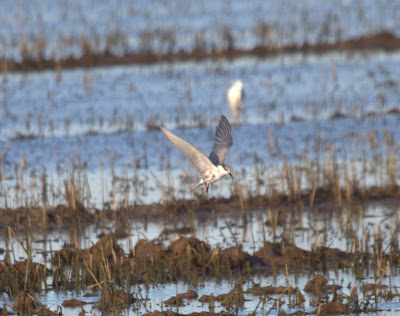This blog post summarises a collaboration by Jesús Solana, author of the observations listed below. Fellow observers for the 6.12.2011 record were Vanessa de Alba, F. Castro and Antonio Núñez. The only observer on 11.12.2011 was Lorenzo Alcántara.
The Pallid Swift (Apus pallidus) is a summer visitor to Europe, wintering in Africa between the southern Sahara and the Equator. It stays in Extremadura much longer than the Common Swift (Apus apus), from which it is sometimes very hard to distinguish on the wing. The bookend dates in Cáceres are 1 February and 22 November, with arrival before 16 February in one third of the years. There is prolonged passage across the Straits of Gibraltar lasting from February to June in spring and from July to November on the return passage to Africa. There have also been one-off sightings in December and January in various points of the Iberian Peninsula (Prieta and Molina, forthcoming). In Extremadura's case there were no December records before the ones listed below and only one previous January sighting is known, on 24.01.2009 in Mérida by Jesús Solana.
In the village of Alange in Badajoz the first winter sighting of nine birds was made at dusk on 04.01.2010 from the village water tank. On the following day, 05.01.2010, another nine swifts were spotted from the same site. In this same month other observers saw Pallid Swifts at Alange Reservoir(08.01.2010; Ferguss Crystal) and in the industrial estate of Mérida (13.01.2010, Ángel Sánchez). In January 2011 there were other swift sightings in Alange: flocks of 15 and 11 birds on 04 and 05.01.2011. Next winter, the third in a row, six swifts were seen from the water tank and the church square on 29.11.2011, this time being definitively identified as Pallids. One bird was also seen entering roosting holes in the church called Iglesia de Nuestra Señora de los Milagros (see photo).
 Half-hour visits were made to Alange between 01.12.2011 and 15.02.2012 in an attempt to ascertain the status of these swifts, always 15 minutes each side of dusk, though the ideal observation period would have been a full hour, 30 mins before and after dusk. Swifts were seen on all visits, as shown in the enclosed graph, with a minimum of seven and maximum of 15 on 06.12.2011, when there were four observers. Numbers seem to fall away as winter progresses, for unknown reasons, maybe because not all of them survive, maybe because some do migrate. One interesting fact is that all the birds roost in building-façade holes, entering in pairs. Fifty of the 58 records are of two birds sharing the same roosting hole and the remaining 8 records are of birds entering singly. This video shows Pallids entering their roosting holes on 27.12.2011 when the church was decked out with christmas decorations.
Half-hour visits were made to Alange between 01.12.2011 and 15.02.2012 in an attempt to ascertain the status of these swifts, always 15 minutes each side of dusk, though the ideal observation period would have been a full hour, 30 mins before and after dusk. Swifts were seen on all visits, as shown in the enclosed graph, with a minimum of seven and maximum of 15 on 06.12.2011, when there were four observers. Numbers seem to fall away as winter progresses, for unknown reasons, maybe because not all of them survive, maybe because some do migrate. One interesting fact is that all the birds roost in building-façade holes, entering in pairs. Fifty of the 58 records are of two birds sharing the same roosting hole and the remaining 8 records are of birds entering singly. This video shows Pallids entering their roosting holes on 27.12.2011 when the church was decked out with christmas decorations.The commonest bird on Alange Church is the feral pigeon; there are also Spotless Starlings and several Stork's nests providing refuge for House Sparrows. Several of the nesting/roosting holes are occupied by the pigeons and disputes have been observed on three occasions between swifts and starlings for the same holes, though the starlings do not seem to oust the swifts in winter. Partially filled-in holes tend to favour the swifts over the starlings.
 Wintering of Pallid Swifts in Alange in 2011/2012 would not seem to be an isolated event, judging from the sightings in previous winters. No recent similar situations are known in Spain, though something similar was described for Seville three decades ago (Cuadrado et al., 1985). Alange is fairly similar in its features to other towns and villages of Extremadura, but no other January observations are known apart from a couple of January sightings in Mérida (2009 and 2010). In 2011/12 searches were made in Mérida, Hornachos, Valverde de Mérida and Palomas in an attempt to find other wintering sites but the results were always negative.
Wintering of Pallid Swifts in Alange in 2011/2012 would not seem to be an isolated event, judging from the sightings in previous winters. No recent similar situations are known in Spain, though something similar was described for Seville three decades ago (Cuadrado et al., 1985). Alange is fairly similar in its features to other towns and villages of Extremadura, but no other January observations are known apart from a couple of January sightings in Mérida (2009 and 2010). In 2011/12 searches were made in Mérida, Hornachos, Valverde de Mérida and Palomas in an attempt to find other wintering sites but the results were always negative.Sources:
- Prieta, J. y Molina, B. En prensa. Vencejo pálido Apus pallidus. En, Atlas de las Aves Invernantes en España. SEO/BirdLife. Madrid.
- Cuadrado, M., Arjona, S. y Rodríguez, M. 1985. Hibernage du Martinet Pâle Apus pallidus dans le sud de l’Espagne. Alauda, 53: 306-307.









































